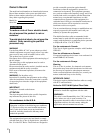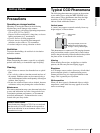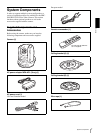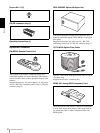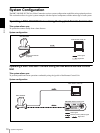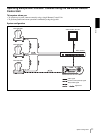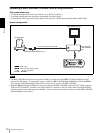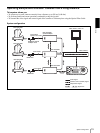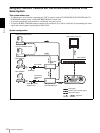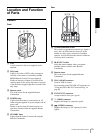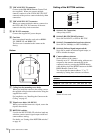
Getting Started
Precautions / Typical CCD Phenomena
5
Getting Started
Precautions
Operating or storage location
Operating or storing the camera in the following
locations may cause damage to the camera:
• Extremely hot or cold places (Operating temperature:
0
°C to 40°C [32°F to 104°F])
• Exposed in direct sunlight for a long time, or close to
heating equipment (e.g., near heaters)
• Close to sources of strong magnetism
• Close to sources of powerful electromagnetic
radiation, such as radios or TV transmitters
• Locations subject to strong vibration or shock
Ventilation
To prevent heat buildup, do not block air circulation
around the camera.
Transportation
When transporting the camera, repack it as originally
packed at the factory or in materials equal in quality.
Cleaning
• Use a blower to remove dust from the lens or optical
filter.
• Use a soft, dry cloth to clean the external surfaces of
the camera. Stubborn stains can be removed using a
soft cloth dampened with a small quantity of detergent
solution, then wipe dry.
• Do not use volatile solvents such as alcohol, benzene
or thinners as they may damage the surface finishes.
Maintenance
The camera mechanism may cause abnormal noise due
to wear and lubrication loss after a long period of use.
To maintain optimum performance, we recommend
periodical maintenance. If abnormal noise occurs,
consult with your Sony dealer.
Typical CCD Phenomena
The following phenomena may appear on the monitor
screen while you are using the BRC-300/300P color
video camera. These phenomena stem from the high
sensitivity of the CCD image sensors, and do not
indicate a fault within the camera.
Vertical smear
A “smear” may appear to extend vertically from very
bright subjects, as shown below.
This phenomenon is common to CCD imaging elements
using an interline transfer system, and is caused when
electric charge induced by infrared radiation deep within
the photo sensor is transferred to the resistors.
Aliasing
When shooting fine stripes, straight lines or similar
patterns, the lines may become slightly jagged.
Blemishes
A CCD image sensor consists of an array of individual
picture elements (pixels). A malfunctioning sensor
element will show up as a single pixel blemish in the
image. This is generally not a problem.
White speckles
When you shoot a poorly illuminated object at a high
temperature, small white dots may appear all over the
entire screen image.
Note on laser beams
Laser beams may damage a CCD. You are cautioned
that the surface of a CCD should not be exposed to
laser beam radiation in an environment where a laser
beam device is used.
Pale vertical
smear
Video monitor
screen
Very bright subject (such as an
electric lamp, fluorescent lamp,
sunlight, or strong reflected light)




